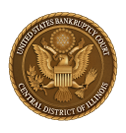United States Bankruptcy Judge
Contact Information
Judge Gorman and her chambers staff may be
reached at:
U.S. Bankruptcy Court
Central District of Illinois
600 E. Monroe Street
Springfield IL 62701
Phone: 217-492-4566*
*Inquiries related to specific cases and the Court's procedures, including electronic filing, order submission, court notices, and the like, should generally be directed to the Clerk's office staff at 217-492-4551.
Zoom Hearing Information:
Zoom Video Hearing Guide for Participants
Most of Judge Gorman's procedures have been incorporated into the Bankruptcy Court Local Rules adopted in 2024 and the accompanying ILCB Guide to Practice & Procedures. The procedures previously posted here have since been archived. A link to Judge Gorman's archived procedures can be found at the bottom of this page. Judge Gorman strictly enforces the Court's Local Rules as supplemented by the Guide to Practice & Procedures and the following additional procedures.
Judge Mary P. Gorman’s Procedures
for Cases Filed in the Springfield Division and
Chapter 7 and Chapter 11 Cases Filed in the Urbana Division
Updated September 16, 2025
|
Ex Parte Contacts Prohibited |
Ex parte contacts are strictly prohibited. See Fed.R. Bankr. P. 9003(a). Any attempt by a party, an attorney, or their staff to contact the Court directly or through chambers staff to seek information about a pending case or advice about practicing before the Court is prohibited conduct. Neither Clerk’s office staff nor chambers staff is authorized to grant oral requests for the continuance or rescheduling of a matter. Except in the case of an emergency, all requests for continuances or rescheduling must be made in writing and filed electronically. |
|
Local Rules and Admission to Practice |
The Local Rules for the United States Bankruptcy Court for the Central District of Illinois apply to proceedings before this Court and can be found, along with other procedures, on the Local Rules, Procedures & Standing Orders page of the Bankruptcy Court website. Attorneys who intend to practice before this Court must be licensed to practice in the Central District of Illinois and should familiarize themselves with this Court's Local Rules and the ILCB Guide to Practice & Procedures. |
|
Fee Applications |
The Court strictly enforces the requirements set forth in the Bankruptcy Code and Rules regarding applications for an award of professional fees and expenses. See 11 U.S.C. §330; Fed.R.Bankr.P. 2016; In re Vancil Contracting, Inc., 2008 WL 207533 (Bankr. C.D. Ill. Jan. 25, 2008); In re Minich, 386 B.R. 723 (Bankr. C.D. Ill. 2008). Reference should also be made to this Court’s Local Rules, Guide to Practice & Procedures, and standing orders in effect regarding fees, all located on the Local Rules, Procedures & Standing Orders page of the Bankruptcy Court website. |
|
Motions for Relief from Stay |
Motions for Relief from Stay which seek relief with respect to property based on a perfected, secured interest in such property must have copies of all documents necessary to support movant’s claim attached as exhibits. Copies of any documents which are required to be recorded in order to perfect a secured interest must include the recording information. Motions for Relief from Stay filed without proper attachments may be stricken without further notice. See the Bankruptcy Court's Local Rules for additional information. |
|
Motions Granted without Hearing in Chambers |
Because the Clerk of Court sets all hearing and objection dates without attorneys being able to self-select available dates, the Court does consider motions for continuances, rescheduling, and extensions of time in chambers. The Court also considers some routine and uncontested matters in chambers. Motions to continue specially set matters may also be considered in chambers. Motions to continue set matters must contain a specific reason for the request and state whether opposing counsel has been contacted regarding the request and consents to the request. If the Court rules on a motion in chambers, a minute order or text order will be entered and attorneys will receive prompt electronic notification of the ruling. See Fed.R.Bankr.P. 9022(a). In the absence of an order from the Court, no party or attorney should assume that a matter has been or will be ruled on in chambers. |
Click here to view Judge Gorman's Archived Procedures.
